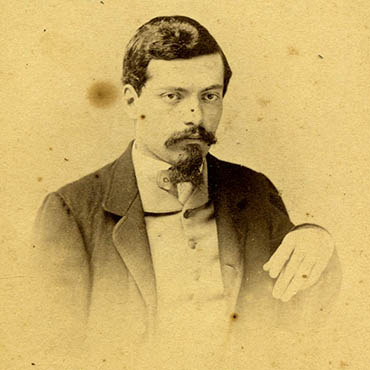Schiaparelli, who was born at Savigliano (Cuneo) in 1835, was fascinated by astronomy since he had been a schoolboy, and learnt the first principles thanks to one of the workers employed in the kiln owned by his father. In 1850 he entered the University of Turin, where he studied with Giovanni Plana, Carlo Ignazio Giulio and Luigi Federico Menabrea, leaving four years later as a hydraulic engineer and civil architect. He continued as an amateur his astronomical studies and observations, but when his plan to become an assistant in the Turin observatory failed, in 1856 he started to teach mathematics in the Porta Nuova high school.
Thanks to the good offices of Carlo Ignazio Giulio at the Ministry of Education, he received a grant to go abroad, firstly to Berlin, where he had the opportunity to study astronomy with Karl Weierstrass, Johann Christian Poggendorff and Johann Franz Encke, and then to Pulkovo (Saint Petersburg), where he perfected his observations under the guidance of Otto Wilhelm von Struve and Friedrich August Theodor Winnecke.
In 1860, on his return, he started to work at the Brera Astronomic Observatory as second astronomer. Two years later and after making a number of discoveries that hit the headlines, he became director of the Observatory, while still very young. This promotion was followed by a number of ministerial posts in teaching (in which he took little interest) and in the organisation of the Italian observatories. His studies on falling stars, carried out in the second half of the sixties, earned him various international prizes, as well the gold medal from the Società dei XL.
Thanks to the acquisition of ever more powerful telescopes, from the middle of the seventies he devoted himself to the study of Mars, observing and describing its appearance in a series of Memorie, published in the “Atti della R. Accademia dei Lincei”. His theories on a series of canals branching out over its surface, which later proved to be optical illusions, gave rise at the time to an international debate covering a variety of interpretations, which led him to consider “not entirely absurd” the hypothesis of the presence on the planet of “a race of intelligent beings”. His observations were not limited to Mars, but ranged from Saturn to Uranus and from Jupiter and its satellites to Venus and Mercury, of which he investigated the periods of rotation.
He busied himself with stellar statistics, geophysics, geodesy, mathematics and meteorology and, last but not least, the history of ancient astronomy. His work was frequently recognised with the most prestigious awards, including the Bruce medal from the Astronomical Society of the Pacific. He was a member of many national and international societies and academies and, from 1885, of the Consiglio superiore della Pubblica Istruzione. In 1889 he became a senator of the Kingdom of Italy.
As early as 1900 he gave up his post at the Brera Observatory because of serious problems with his eyesight and died in Milan in 1910 following a stroke. Schiaparelli was one of the consultants – a sort of scientific committee for the national edition of the works of Galileo appointed by the Ministry of Education to work side-by-side with Antonio Favaro – together with Valentino Cerruti and Gilberto Govi. Schiaparelli was one of the people that clashed with Isidoro Del Lungo on the criteria to follow in the publication of the texts of Galileo, giving priority to legibility over the intrusion of critical notes. Even when these critical notes met the expectations of the more intransigent philologists, he considered them to be unreasonable. He maintained a longstanding relationship with Antonio Favaro, even if he was not able to keep his promise to contribute to the edition of the observations on the Medicean Stars for the second part of Vol. 3 of the Opere di Galileo.


